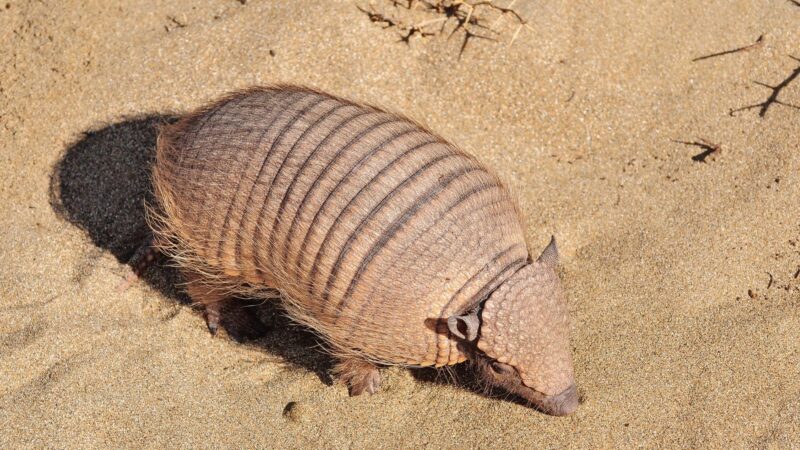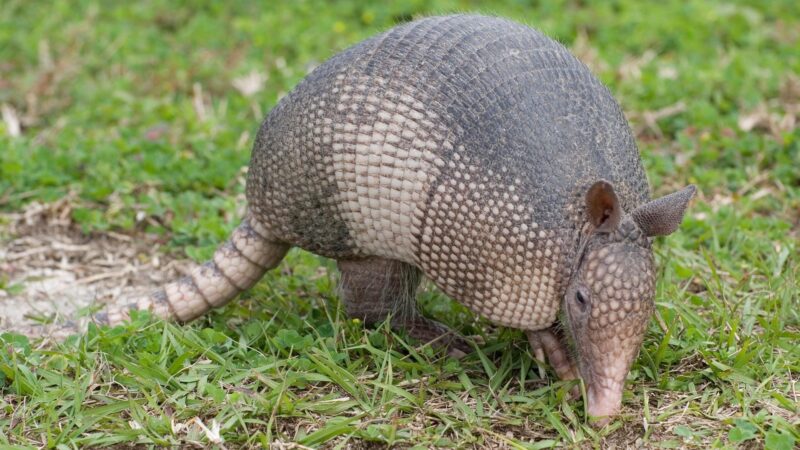Some gardeners consider armadillos beneficial, while some treat them like troublemakers. The question of whether these creatures are good or bad mainly depends on their behavior.
But somehow, it appears that more people prefer eliminating armadillos instead of allowing them to stay in the garden or yard.
How to get rid of armadillos? Getting rid of armadillos can be done by installing motion-activated sprinklers, an in-ground fence or electric fence, or live traps. But even if killing armadillos is legal in your area, avoid shooting at them. Armadillos are not common during the day, and using a gun at night is quite dangerous.
Armadillos are not social and territorial mammals. This means that the one that cause trouble to your yard last week may not be the one causing trouble today.
To get rid of armadillos, you should first understand their behavior. In this article, you will learn some important facts about armadillos, and how to control them.
Table of Contents
What Are Armadillos?

Scientifically known as Dasypodidae, armadillos are mammals known for having natural body armor. In Spanish, the term “armadillo” means “little armored one”.
There are about 20 armadillo species around the world but only one can be found in the United States – the nine-banded armadillo (Dasypus novemcinctus).
Armadillos were first spotted in South and Central America and started to spread all over America in the 1850s. The earliest fossil of an armadillo ancestor found was said to be from 60 million years ago.
At that time, armadillos were as huge as rhinoceros. Among the closest relatives of armadillos are anteaters and sloths.
What Do Armadillos Look Like?
Armadillos look like prehistoric animals due to their barrel-shaped body that has a rough but flexible outer shell with bony plates.
These rectangular scales called osteoderms grow naturally in the skin and are about 16% of the animal’s body weight. They cover the entire body of armadillos, except for the ears and belly.
Also called long-nosed armadillos, nine-banded armadillos have 9 movable bands on the middle of their body, hence the name. Some of them have 8 or 11 bands, though.
Their scales grow continuously and wear naturally but will never shed completely. They have a pink, soft snout like a pig but no front teeth.
Armadillos can grow between 2 and 2.4 feet (24 and 31 inches), or as big as ordinary cats. Females weigh 3.6 to 6.0 kg (8 to 13 pounds), while males weigh 5.5 to 7.7 kg (12 to 17 pounds). These peculiar mammals are great swimmers and agile runners, and can twist their bodies, but have poor hearing and eyesight.
What Are Armadillos Good For?
Armadillos are good for controlling pest insects in the garden. Being excellent excavators, they dig holes in the soil and use their sticky tongues to forage for small insects such as ants, beetles, termites, wasps, and yellowjackets. Amazingly, they can eat thousands of fire ants in a single meal, without being harmed.
Are Armadillos Bulletproof?
Contrary to what many people think, armadillos are not bulletproof. Although some reports claimed that bullets have bounced off their bodies, animal experts have doubted if they were true. Instead, their body armor can only be compared to a hard-shelled suitcase. In fact, even big dogs can easily break their shells.
Are Armadillos Intelligent?
Armadillos are not intelligent enough. Instead, they tend to disregard threats and danger. These odd-looking animals are also curious, determined, and love to investigate things.
However, they lack intelligence, especially when it comes to escaping. This is probably because armadillos think that they are invincible.
Where Do You Find Armadillos?

You can find armadillos in temperate and warm places such as deserts, forests, and grasslands. Due to having low metabolic rates, they prefer living in areas where there is sunshine rather than in colder climates.
No wonder, armadillos are commonly seen during summer. Sometimes, they can be seen in warm winters.
What Attracts Armadillos to Your Yard?

Armadillos are attracted to your yard because they love to dig burrows for their nests and food storage. Using their noses and forelimbs, they dig several holes that are about 1-5 meters (3.3-16 feet) long, 18–20 cm (7-8 inches) in diameter, and can be up to 2 meters (6.5 feet) deep. Armadillos prefer sandy soils, though.
Are Armadillos Bad to Have Around?
Armadillos are bad to have around. Despite being harmless and predators of insect pests, these armored critters can cause severe damage to your lawn, flower bed, and yard.
Being omnivore creatures, they sometimes eat plants, fruits, vegetables, and seeds. In short, they may also destroy vegetable gardens.
Armadillos may dig holes in patios, golf courses, and driveways and eventually cause structural damage. Nine-banded armadillos are carriers of the bacteria Mycobacterium leprae, which causes Hansen’s disease (leprosy). Although rare in the US, it can also be transmitted via person-to-person.
Leprosy affects the eyes, nose, skin tissue, and nerves. If left untreated, it can lead to paralysis of the hands and feet, and numbness.
Most people have natural immunity against leprosy, but the bacteria grow very slowly. Fortunately, the risk of transmission to humans via direct contact with infected armadillos is very low.
What Do Armadillos Hate?

Armadillos hate the cold weather. Although they don’t hibernate in the winter, these friendly mammals are not so active during this season. Armadillos also have an incredible sense of smell, and they hate the smell of ammonia, castor oil, cayenne pepper, garlic, and vinegar. They will run once they smell them.
What Keeps Armadillos Away?
Currently, there are no commercial products registered as armadillo repellents. Some scents can repel armadillos and prevent them from digging in your yard.
But since rain can wash them away and their smell will eventually run out, these varmints will later return. Here are some alternatives to keep armadillos away:
- Motion-activated sprinklers
- Fence
- Live traps
How Do You Make an Armadillo Trap?
DIY (do-it-yourself) armadillo traps are not really hard to make and will not cost you much. Depending on the location, these live traps can catch armadillos effectively.
If you don’t know where armadillos are coming from, your traps should have openings on both ends. Here are some tips on how to make an armadillo trap:
Wooden DIY Armadillo Trap (2-Door Trap)
- Cut 4 pcs. of plywood, 12 x 12 x 36 inches. They will be used for the top, bottom, and two sides of the trap.
- Cut 2 pcs. of plywood, 12 x 15 inches. They will be used for the front and back trap doors.
- Make a box out of the plywood, except for the front and back, which are both for the trap doors.
- Get a 1/2 x 12-inch wooden dowel or a 1/2 x 1/2 x 12-inch wood. This will serve as the trap pin.
- Drill a 1-inch hole on top of the box. This is where you will insert the trap pin.
- Construct three 30-inch high frames. The two frames are for the trap doors, while the other one is for the center of the box.
- Hang a hook on top of the center frame. This will be used for the pulleys of the trap doors.
- Place hooks on the top of each of the trap doors and a small hook on one end of the trap pin.
- Place a small nail near the other end of the trap pin. This will serve as the trigger for the trap doors.
- Place each trap door at the front and back of the trap.
- Using fish wire, tie the hook of the center frame to the hook of the trap pin, as well as to the hooks on both trap doors. This will serve as the trap mechanism.
- Make sure the armadillo can enter the trap and the trap door will immediately close once the animal touches the trap pin.
PVC Pipe DIY Armadillo Trap
- Use a 6-inch diameter PVC pipe or a diameter that would fit the nest opening of the armadillo.
- The length will depend on your available space, but it should be at least 2 feet long.
- Put a screen on the end of the pipe so you can still see the trapped armadillo inside. Make sure the animal cannot push the screen.
- Dig a hole at an angle of about 45 degrees, with the opening end at the nest level.
- Place the PVC pipe trap on the hole, with the open end touching the nest opening
- Once the armadillo leaves its nest, it will enter the pipe and can no longer escape.
Bucket DIY Armadillo Trap
- Use a 5-gallon bucket or even bigger and deeper.
- Bury the bucket in the soil, very close to the burrow opening.
- Cover the bucket with some dirt, leaves, newspaper, and bait.
- Once the armadillo steps on the trap, it will fall and can no longer escape.
How Do You Get Rid of Armadillos Naturally?
As mentioned above, armadillos love to dig burrows in yards or under the house. They like well-irrigated soil simply because it is easy to dig. Soil insecticides can help reduce armadillos.
However, they can damage your lawn since you need to apply them frequently. To help you out, here are the natural ways to get rid of armadillos:
1. Reduce Food Sources
Since armadillos feed on insects, try eliminating them. This technique can be tricky though because you might also eliminate some beneficial insects.
Also, remove tall grasses, bushes, and shrubs, and pick up debris and fallen fruits. Once there are no more attractants, armadillos will eventually find another place.
2. Place Motion-Activated Sprinklers
Since armadillos are most active at night, use Orbit Motion-Activated Sprinkler, which has day and night and night-only capabilities. Armadillos will jump several feet off the ground when they can get startled by this device. To be more effective, place this motion-activated sprinkler near the nests of armadillos.
3. Install an In-Ground Fence
For better stability, use wood or metal for your fence. Since these hard-bodied animals rarely climb, it can be only 2 feet high. But then, bury the fence about 2 feet deep to prevent armadillos from passing through even if they dig outside. Place the fence at an angle of 45 degrees, so the animals cannot jump over it.
4. Install an Electric Fence
If digging for a fence can be tough for you, try installing an electric fence such as RentACoop Poultry Netting Electric Fence. This simple but sturdy fence is 13 feet long and 4 feet high and comes with double spiked posts for additional support. To avoid harming your children and pets, use a low-impedance energizer.
5. Place Live Armadillo Traps
If you cannot make your own armadillo trap, buy animal traps designed for them. The Havahart 1079SR 1-Door Live Animal Trap is an ideal choice in terms of durability and dimension. To make sure it can trap armadillos, place it near their nests and put physical barriers around the trap or funnel to guide the animals.
Is Bait Necessary for Armadillo Traps?
In most cases, bait is not necessary when trapping armadillos, especially if the funnels are properly in place. But if you will use bait, use overripe or spoiled fruits since they attract flies.
However, other animals may be attracted to them. So far, the most recommended baits for armadillos are live earthworms or mealworms.
Is It Legal to Relocate or Shoot Armadillos?
Check your local laws if you are allowed to relocate armadillos. If so, release the animal about 25 miles away from your house and in a moist, warm environment where it can survive.
Meanwhile, shooting nuisance armadillos is illegal in some states. This technique is also dangerous since armadillos are most active at night.
Frequently Asked Questions
Do Armadillos Always Have 4 Babies?
Nine-banded armadillos give birth to four identical babies in every litter. These quadruplets have the same gender. Also called pups, armadillo babies are much smaller than adults and have softer bodies.
But no, not all armadillos have 4 pups. Seven-banded armadillos can have 8 to 15 identical pups in a single birth.
Do Armadillos Keep Snakes Away?
Armadillos don’t keep snakes away. They are not known for eating snakes, while snakes can eat them. But because of their hard-shelled bodies, some snakes will find it hard to bite them.
If a small snake attacks an adult armadillo, the mammal may simply ignore it or will cut its body using its body armor.
Will Armadillos Chase You?
Armadillos don’t chase humans and pets. Despite being wild animals, they are not aggressive and will not attack you. Instead, these near-sighted mammals may follow you if you will not pose any threat to them.
They will run away or hide in burrows if you chase them. Some species roll their bodies when endangered.
Can Armadillos Be Pets?
Armadillos should not be kept as pets since they are not trainable. Despite being affectionate and docile, these cute creatures are not that smart to learn tricks.
Aside from that, armadillos are wild animals and should always be in their natural habitat. But more importantly, owning armadillos is illegal in most states.
What Time of Night Do Armadillos Come Out?
Armadillos are primarily nocturnal animals, which means that they are active at night and rest during daytime hours. Interestingly, they can also be crepuscular or active during twilight hours, through the early morning. Nevertheless, armadillos are most active from 2 AM to 5 AM., especially during very hot summer months.
Where Do Armadillos Go During the Day?
As weird as it seems, armadillos sleep the whole day for about 16 hours. During these hours, they can be found in their underground nests.
But when the weather is warm, they may still come out to forage, especially when food is scarce at night. Armadillos are solitary animals and socialize only during mating season.
Summary
Despite eating insect pests, armadillos are still considered pests rather than beneficial. In most cases, the damage they cause requires a lot of time to repair and can be expensive, too.
If you have tried all strategies above but armadillos keep on coming back, the only technique is to call professional pest control.
List of Sources
Tips for Managing Nuisance Armadillo
The Nine-Banded Armadillo (Dasypus Novemcinctus)
Armadillos in Missouri: Techniques to Prevent and Control Damage